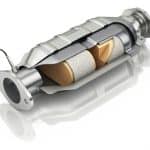
The exhaust manifold is the part of the car that delivers exhaust gases to your car’s exhaust. Symptoms that your manifold may need replacing include visible cracking on the part’s surface, the presence of exhaust odours within the interior of your vehicle and a loss of performance. Excessive noise coming from your bonnet may also indicate that you have a problematic manifold, whilst noise coming from the rear of the car is more likely to indicate a damaged or faulty exhaust.
Replacing your car’s exhaust manifold is not a difficult or complicated job as the part is easily accessible from the bonnet and is simply bolted onto the main engine block. As with all mechanical work on your car’s engine it is best to work in a well-lit area or even outside on a sunny day. You will also need to jack up the car in order to get under your vehicle in order to access the exhaust outflow pipe.
What you’ll need: Car jack, jack stands, socket or wrench set, flat knife and a gasket kit.
Locate the Manifold and Remove the Air Intake
The first step is to find the manifold, which should look like a series of outlets connected to a single tube coming off the central engine block. Access to the manifold may well be impeded by your car’s air-intake and the carburettor. If this is the case you will need to unplug all hoses that are connected to the carburettor before unclipping it from the engine and gently wiggling it out of its sitting, then finally unplugging the throttle cable.
Disconnect the Exhaust Manifold
Now the exhaust manifold is exposed, you should have sufficient room to detach this part from the engine block. It will be held in place by a number of bolts that sit on either side of each outlet, which ensure that the manifold is held flush against the engine block. When all of these are removed gently pull the manifold out of it’s position.
Remove Exhaust Pipe
Get under the car and now disconnect the exhaust pipe from the manifold. This is held in position by two bolts and a hanger. When these are removed you should be able to slide the exhaust pipe out of the engine, leaving the manifold free to be completely removed from the car.

Remove the Old Gasket
Remove the old gasket. This is a piece of rubber that’s used to keep the gap sealed between the engine block and the manifold. There may be pieces of the old gasket stuck in place on the engine block, which will have to be carefully removed with a flat knife, attacking the pieces from underneath to lift them off the block.
Replace the Gasket and Exhaust Pipe
Next fit the new gasket into position around the bolt holes on the engine block. This should simply slip into place. Now reattach the exhaust outflow pipe to the manifold in preparation to ready the new part for connection with engine block.
Connect the Exhaust Manifold
You should now be able to fit the replacement exhaust manifold on top of the gasket. Wiggle this part into place and loosely place the bolts in their holes to keep the manifold in the correct holes to ensure the part is held in position. When you are satisfied this is the case tighten all the bolts until the manifold is held flush against the engine. Finally reattach the carburettor if you removed it from the engine and take the car off the jack props.
When you have completed the reattachment work the easiest way of checking that everything has been fitted correctly is to simply run the engine. If there are any problems with the installation of the exhaust manifold you will see gasses escaping from the engine and there may also be a noise associated with this leak. Locate the leak and tighten the fixings around this accordingly to solve any problems.
UP NEXT: Changing Your Car’s Exhaust Back Box













.png)